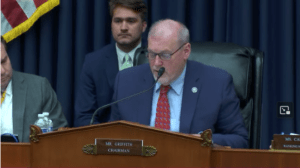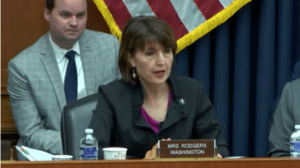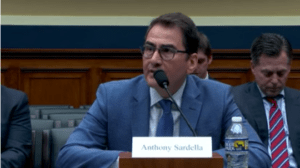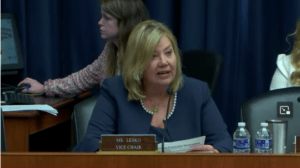What’s causing all of America’s drug shortages, and what is more important for American medical needs – drug safety, or supply certainty? It’s a battle the Food and Drug Administration (FDA) wrestles with daily given U.S. dependence on foreign manufacturers, particularly in China and India for generic medicines which account for 90% of all prescriptions dispensed.
The House Energy and Commerce’s Subcommittee on Oversight and Investigations held a hearing on Thursday to weigh what was at stake, and what was the root cause of the shortages of things like amoxicillin, a critical drug used in patients suffering from pneumonia, among other things.
In Thursday’s hearing, titled “Examining the Root Causes of Drug Shortages: Challenges in Pharmaceutical Drug Supply Chains”, the Oversight Subcommittee’s Chairman, Morgan Griffith (R-VA), said there has been a 30% increase in drug shortages between 2021 and 2022, and noted that the U.S. faces some 200 active drug shortages at the moment. He voiced concern over reliance on foreign countries for Active Pharmaceutical Ingredients (API), especially from China and India. He called on the FDA to increase the number of domestic production applications for drugs made by U.S. labs rather than simply opening the floodgates to more imports.
The House Energy and Commerce Committee’s Chairwoman, Cathy McMorris Rodgers (R-WA), criticized the FDA’s failure to source and collect data on APIs and finished medicines in her opening remarks. She noted that 80% of APIs and 60% of finished drugs come from labs abroad. She voiced concern about reliance on imports and urged for the creation of government programs to promote generic drug manufacturing and increase drug supply chain ingredients.
Here is a quick summary of Congressional remarks, opening statements from the witnesses, and some of the Q&A session. These are summaries and may not be verbatim quotes. Verbatim quotes will be in quotation marks below:
 Rep. Morgan Griffith: “Over the past 10 years, the United States has seen dozens of generic drug manufacturing facilities close. And this shortage problem isn’t limited to just closings. The typical generic drug has just two manufacturing facilities. We currently do not fully utilize the factories we have. We only use about half of our current generic manufacturing capacity. We now have fewer manufacturing facilities in the U.S. and globally and our supply chain has proven to be fragile and vulnerable to disruption. We need an FDA that prioritizes applications from U.S. manufacturers and gives companies the flexibly to address shortages with resources based here.” [Testimony]
Rep. Morgan Griffith: “Over the past 10 years, the United States has seen dozens of generic drug manufacturing facilities close. And this shortage problem isn’t limited to just closings. The typical generic drug has just two manufacturing facilities. We currently do not fully utilize the factories we have. We only use about half of our current generic manufacturing capacity. We now have fewer manufacturing facilities in the U.S. and globally and our supply chain has proven to be fragile and vulnerable to disruption. We need an FDA that prioritizes applications from U.S. manufacturers and gives companies the flexibly to address shortages with resources based here.” [Testimony]
Rep. Cathy Rodgers: “The FDA has not been an effective partner in combatting drug shortages. Even after Congress provided FDA new authority in 2020 to get more information regarding where American prescription drugs are made, we still do not have good data on where either finished medicines APIs are sourced. FDA last testified that around 80%  of API facilities and 60% of finished dosage facilities are overseas, including India and adversarial countries, like China. These are countries limit our foreign drug inspection program’s ability to operate adequately. It’s an enormous problem if we cannot properly inspect the quality of ingredients in common drugs Americans rely on. This situation not only raises concerns over drug quality, but also poses a significant threat to our national security. If adversarial countries were to cut off the supply of necessary APIs to manufacturers, American patients’ lives could hang in the balance…. I am encouraged by the bipartisan nature of this hearing. This is a critical issue that transcends political party lines.” [Testimony]
of API facilities and 60% of finished dosage facilities are overseas, including India and adversarial countries, like China. These are countries limit our foreign drug inspection program’s ability to operate adequately. It’s an enormous problem if we cannot properly inspect the quality of ingredients in common drugs Americans rely on. This situation not only raises concerns over drug quality, but also poses a significant threat to our national security. If adversarial countries were to cut off the supply of necessary APIs to manufacturers, American patients’ lives could hang in the balance…. I am encouraged by the bipartisan nature of this hearing. This is a critical issue that transcends political party lines.” [Testimony]
* * *
Witness Testimony: A Summary
Alex Oshmyansky, MD and CEO of famous investor and Shark Tank star Mark Cuban’s Cost Plus Drug Company, told the Committee that drugs to treat cancer and other illnesses were in shortage, which leads to difficulties in treatment patients, and in worse case scenarios, even death. He voiced concern over the inability of the U.S. to produce the required number of relatively simple drugs here at home. He advocated for a public-private partnership to build the necessary infrastructure to solve the drug shortage crisis.
Anthony Sardella, Chair, API Innovation Center, Adjunct Lecturer & Senior Research Advisor, Center for Analytics & Business Insights: He recommended increasing domestic drug production, addressing economic volatility in the pharmaceutical market, and public-private partnerships. He explained that the low cost of generic medications leads to low revenue, which leads to cost-cutting, inadequate factory maintenance, and limited product development. He said that many generic drug companies could not even afford to address FDA warning letters because of low revenue. He even called for turning vacant auto-manufacturing plants into drug labs. He estimated that half of the auto plants that are shrinking due to EV production and shifts to manufacturing in Mexico could be brought online and transformed within a year, and 80% in two years, which would result in 30 billion doses produced. He recommended the U.S. create quality scores to allow drugs to compete on market shelves and advocated for the federal government to use its large healthcare purchasing influence to favor domestic drug makers.
Laura Bray, Founder, Angels for Change: Said her child’s cancer treatment experienced drug shortages for a complex drug cocktail. She added that the hospital was unable to find the necessary drugs three different times, leaving her family to scramble to find them. She voiced concern over the number of hearings and studies that have addressed and identified problems in the drug supply chain but not enough action has been taken to remedy the problem.
Fernando Muzzio, PhD, Distinguished Professor of Chemical & Biochemical Engineering, Rutgers University: He told the Committee that 60% of drug shortages are from quality issues, or economic reasons. He added that advanced manufacturing methods could reduce quality risks, rather than the traditional batch method, which relies on 10 to 30 samples of a 10 million to 30 million dose batch.
* * *
Samples from the Q&A Session:
On Warning Letter recipients still shipping drugs to the U.S….
Chairman Morgan Griffith: What percentage of generic drugs are made in facilities that have received an FDA warning letter?
Anthony Sardella: About 25% of generic drugs over the last 26 months were made in facilities that have received FDA warning letters.
Griffith: Do these warnings stay open for a while?
Sardella. Yes. Companies do not have the capital to address the FDA written warnings often result in companies shutting down or just not complying or just continuing to operate.
Griffith: Drugs produced in plants with an FDA warning have resulted in deaths. Doesn’t the U.S. need to better deal with plants operating with FDA warning letters?
Sardella: Yes.
On dealing with drug shortages…
Rep. Frank Pallone (D-NJ): What current gaps of knowledge about the pharmaceutical supply chain exist?
Muzzio: There is a lack of focus on chemical building blocks in government reports on manufactured drugs abroad, especially about how API manufacturers source those key starting materials and where from. The FDA needs to identify where shortages originate, such as problems with those key starting materials. You need greater transparency of the drug supply chain if you want to identify faults and you need to build domestic production.
Pallone: Where has the FDA been most effective in solving the drug shortages and could greater transparency into foreign supply chains help improve their work?
Bray: The FDA’s Center for Drug Evaluation and Research has been the most helpful and communicative. We need a more preventive and proactive approach rather than be reactive and always doing mitigative strategies to cope with drug shortages.
Griffith: What does the U.S. API industry need to achieve a minimum level of self-sustainability.
Sardella: The cost of bringing prescribed medicines and the top 40 essential medicines back to the U.S. to stabilize U.S. supply chains is less than $2 billion.
Rep. Jeff Duncan (R-SC): We have too much reliance on foreign APIs for the U.S. healthcare system. What exactly are the risks of foreign reliance?
 Sardella: Reliance on imports could lead to supply shocks in critical drugs and resources because countries could blockade drug imports in response to geopolitical events. You need domestic production of APIs to avoid drug shortages but generic drug production is usually unprofitable.
Sardella: Reliance on imports could lead to supply shocks in critical drugs and resources because countries could blockade drug imports in response to geopolitical events. You need domestic production of APIs to avoid drug shortages but generic drug production is usually unprofitable.
Rep. Dan Crenshaw (R-TX): Why don’t we have API manufacturers here?
Sardella: It is not usually economically viable here. API manufacturers favor countries with low-labor costs, and government benefits.
Duncan: Would the drug price negotiation provisions of the Inflation Reduction Act make it harder or less profitable for a generic in development to come to market for a brand name subject to negotiation?
Sardella: The goal of the U.S. should be to improve production methods to improve the economic viability of generic drugs made here. New manufacturing technology reduces costs by 90%. Preferred, critical drug lists could incentivize the implementation of new domestic drug manufacturing.
At least one Subcommittee member asked about creating legislation that would provide for tax incentives to produce generic drugs here at home. Rep. Gary Palmer (R-AL) said that there was now an obvious need to increase the production of new drugs. “Would incentives or tax credits be helpful to companies?” he asked.
Sardella, who was the star of the Witness panel Thursday, said incentives would “very much” help. He gave an example of a Missouri, where his non-profit bought the new advanced manufacturing equipment for labs that made it easier to make the medication at home. He cited some cancer drugs. But he also noted that tax incentives are not the only solution. “When you have an industry with such low profitability, tax incentives are less effective. You also need certainty of demand,” he said.
Palmer explained that the Clinton Administration’s repeal of Section 936 of the U.S. Internal Revenue Code, which were incentives for drug manufacturers, caused a mass exodus of drug companies to foreign countries. “We saw an exodus to many countries. I remember Horizon Pharma out of Chicago moving to Ireland because they were not subject to US taxes and their tax base went down to 12%. What about reinstating Section 936?” Sardella reiterated that tax incentives would help bolster U.S. domestic manufacturing.
“I think tax incentives and breaks are part of the solution,” Palmer said.
On FDA inspections abroad…
Rep. Debbie Lesko (R-AZ): The COVID-19 pandemic halted FDA’s foreign drug manufacturing facility inspections. But even before the pandemic happened, the number of participating facilities had been falling going back to 2016.  There was a Government Accountability Office report stating that the percentage of facilities the FDA has not visited in over five years has grown from 30% in 2020 to 80% in 2022. “The agency is not any better off now in doing foreign inspections,” she said. The FDA only visited six percent of foreign facilities in 2022 that are allowed to export drugs to the United States. There is a danger created by the lack of quality inspections. How important are these inspections to a safe, secure drug supply chain here?
There was a Government Accountability Office report stating that the percentage of facilities the FDA has not visited in over five years has grown from 30% in 2020 to 80% in 2022. “The agency is not any better off now in doing foreign inspections,” she said. The FDA only visited six percent of foreign facilities in 2022 that are allowed to export drugs to the United States. There is a danger created by the lack of quality inspections. How important are these inspections to a safe, secure drug supply chain here?
Sardella: Lab inspections are important for the safety and quality of drugs given to U.S. consumers. Inspections also keep the market stable by understanding which manufacturers are producing quality products, and it rewards facilities that have not received an FDA warning letter with recognition.
Lesko: “The Biden Administration passed a $10 million pilot program to increase the number of foreign inspections at the FDA. However, the agency has cited challenges in the agency’s ability to recruit and retain investigators as a major factor in the delay or dereliction of timely foreign inspections. Mr. Sardella, how confident are you that this pilot program will close the gap in the number of overseas establishments that remain uninspected?”
Sardella: The FDA is not unique in meeting workforce challenges.













